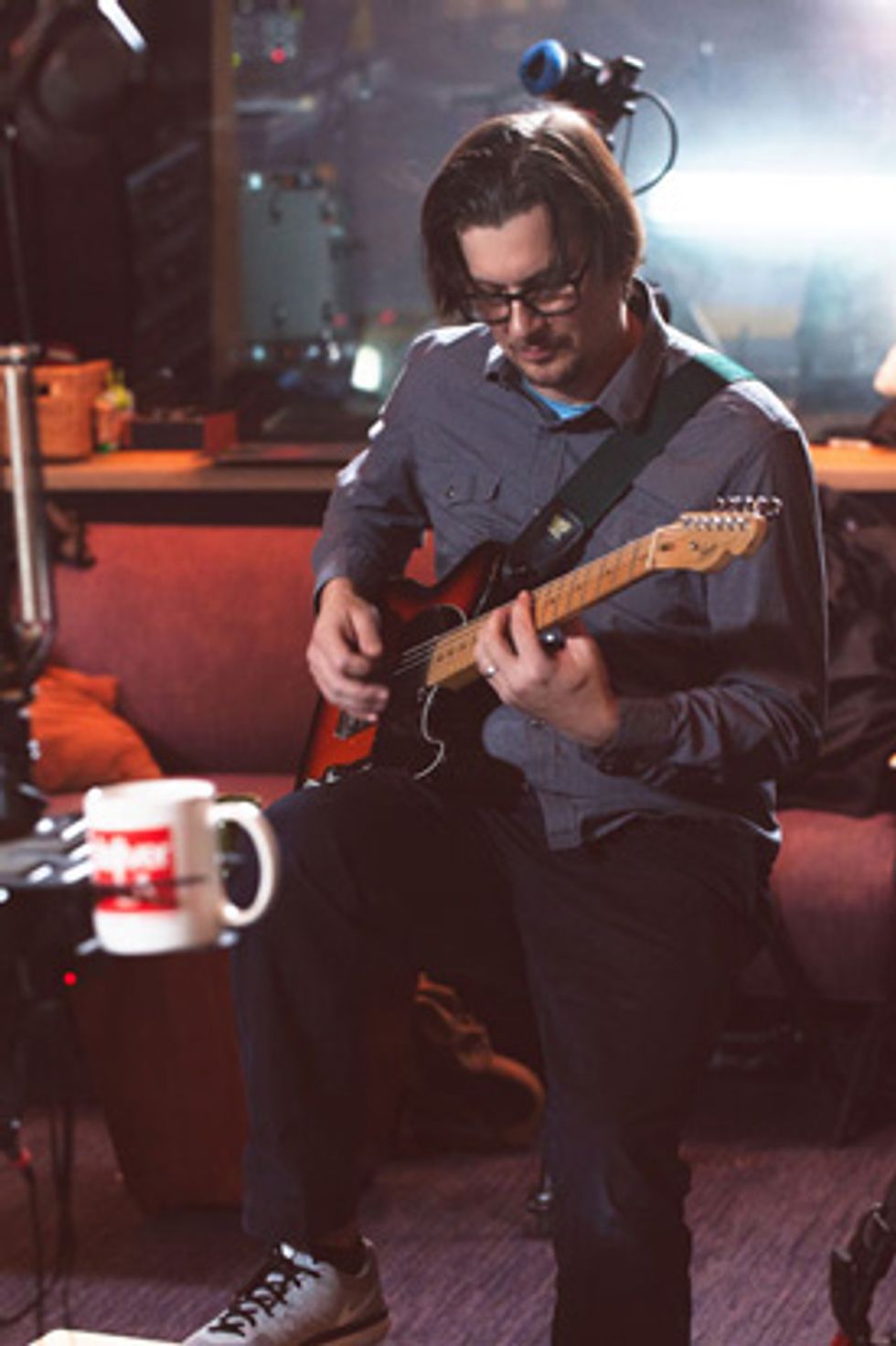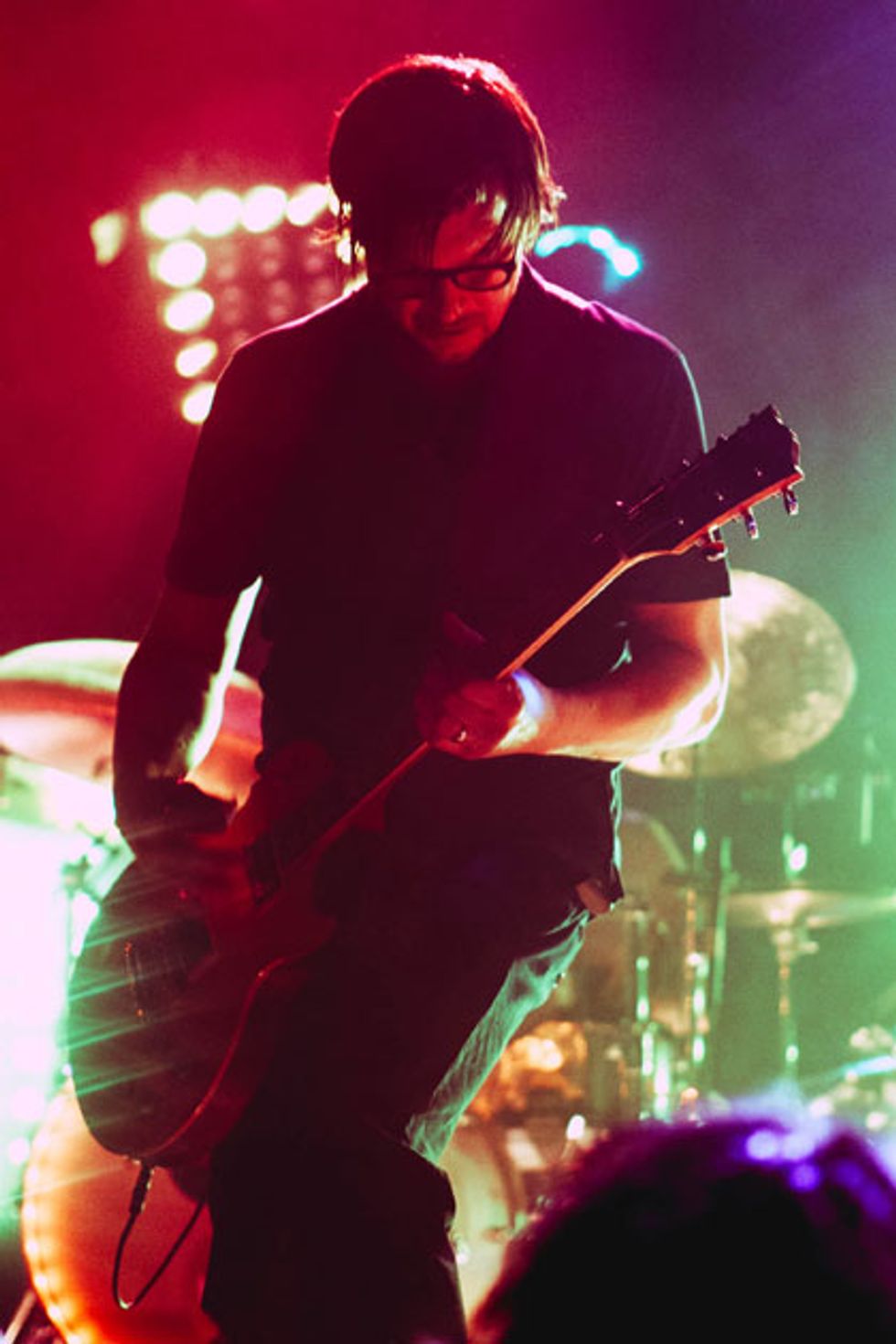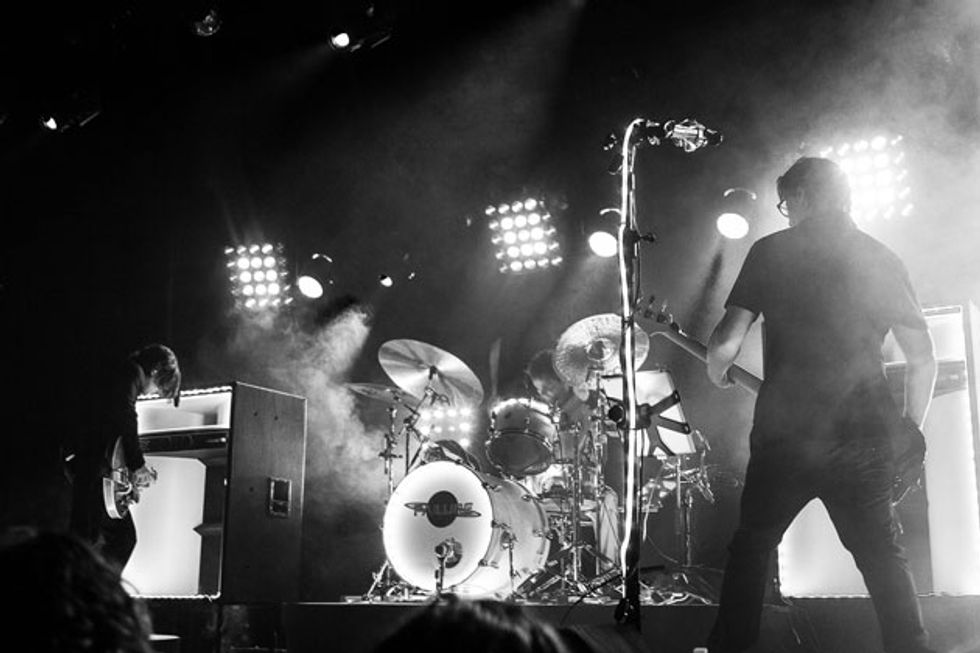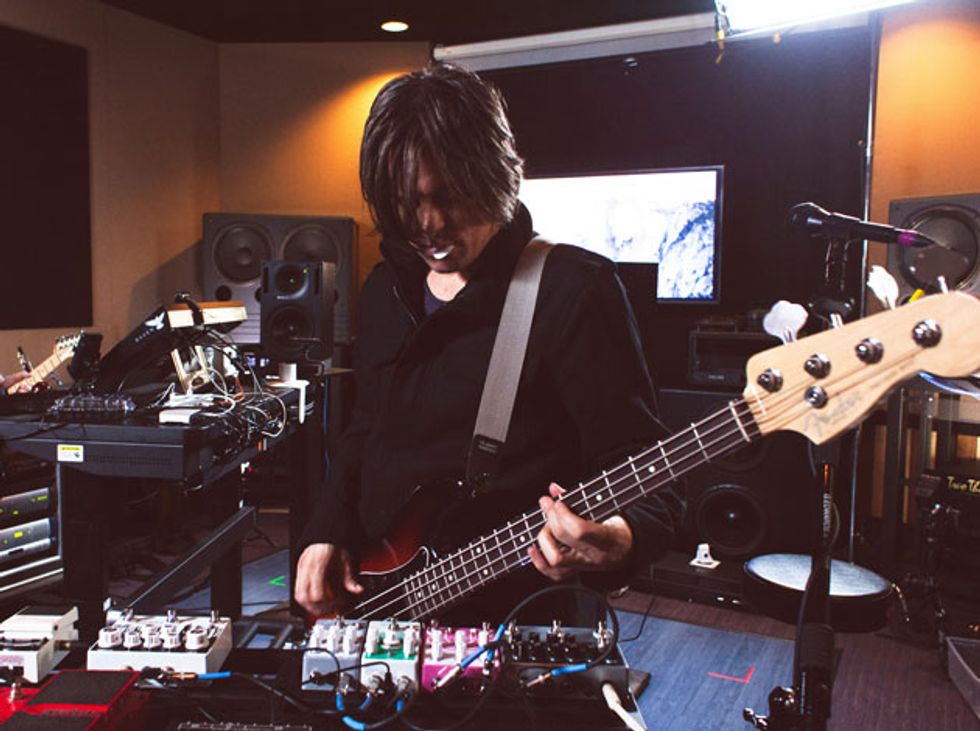The summer of 1996 should have been the breakout year that L.A.-based, space-rock band Failure had been waiting for. They’d just released their third album and magnum opus, entitled Fantastic Planet—an epic rock masterpiece featuring catchy songwriting with near OCD-levels of studio production. Written and produced by band architects Ken Andrews and Greg Edwards, the album’s 17 tracks contained otherworldly atmospherics and textures, driving riffs, and violently heavy bass dirges. Unfortunately, the band’s label was busy fighting financial collapse, and as a result, the record sold dismally. With mounting personal and professional issues, the band called it quits in late 1997.
Failure’s demise 18 years ago is what makes their new album, The Heart Is a Monster,so compelling. Despite the breakup, Failure’s fanbase continued to expand through word-of-mouth, by praises from their contemporaries (Tool’s Maynard James Keenan among them), and from subsequent generations of musicians citing their music as a major influence. Magnified and especially Fantastic Planet began appearing more frequently within lists highlighting the greatest unsung albums of the grunge era.
Several years ago, the trio decided it was time for a proper reunion. They entered Andrews’ Red Swan studio in Los Angeles to begin writing and recording the first Failure album in nearly two decades and one of the most anticipated releases of 2015. The result has the Failure hallmarks of catchy songwriting and exquisite production, and its brooding delivery makes it the darkest album the band has produced to date. We caught up with Andrews and Edwards to discuss what it was like to make music together again, the gear they used, and how their dreams and the work of David Lynch influenced the album.
The Heart Is a Monster is a pretty ambitious album. The heavy layering, lush-sounding textures, and varying segues makes it sound like it’s picking up where Fantastic Planet left off. Was this intentional?
Ken Andrews: It wasn’t in the plan initially, but it ended up being discussed about halfway through the album’s writing process. One thing that we decided early on, however, was that we didn’t want to do a reunion, go on a couple of nostalgia tours, and then call it a day. If we were actually going to put the band back together, we wanted to go all the way as a fully functioning band should, with new material and the whole nine yards.
Greg Edwards: Looking back at the time when we broke up, I’m glad that we didn’t make the follow-up then. The atmosphere surrounding us at that time was pretty toxic with a lot of pressure coming from the industry side of things. I’m not sure what sort of follow-up record that would have created. At the time, I was feeling like anything we made could have tarnished the whole legacy of Fantastic Planet. We were really fortunate to have left right after making a record that was a real statement and also really resonated with people, and continues to do so.
Most of The Heart Is a Monster was written in the studio, which gives you a lot more freedom to shoot from the hip when inspiration hits.
Andrews: There may have been a few parts that Greg and I brought in and kicked around, but yes, most of it was written as we recorded it. We started off a couple of years ago at a pretty slow pace, especially compared to the final days, when we spent long hours every day in the studio.

Ken Andrews is shown here playing the guitar used the most on The Heart Is a Monster—a 1994 Fender American Standard Telecaster with a Seymour Duncan Hot for Tele in the bridge.
Photo by Priscilla Scott.
Both of your lives have changed quite a bit since the band’s breakup in 1997. Was it difficult to recapture a moment in time when you “clicked” musically?
Andrews: We’ve all kept playing or working on music since then, so our musical capabilities have grown. It allowed us to jump into some good ideas pretty quickly without mucking around. And since our sound basically relies on how effectively Greg and I bat ideas back and forth in the studio, the added experience made the process a lot easier than it had been in the past.
Edwards: Yeah, for sure. A big part of what made it easier was that Ken and I first got back together just as friends and new parents. Spending time with our young kids as they were running around and making fun of us was a nice built-in distraction away from the elephant in the room, which was Failure. It was certainly in the air, though. The feeling was that we’d eventually do something together again, maybe a soundtrack or something—but not necessarily Failure.
Since both of you trade off guitar and bass duties in the studio and live, Failure has never really had a “designated” guitarist and bassist. For the new album, did one of you play guitar or bass more than the other, or was it an even split?
Edwards: Ken actually played the majority of the bass on the record, and I played the majority of the guitar parts. I was thinking that after playing guitar in my band Autolux, I would pick up the bass in Failure. I ended up playing mostly guitar, just because that’s how it worked out in the end. Live, I’ll play whatever instrument makes it easier for Ken to sing and play.
The new album revolves around the concept of “inner space,” rather than the outer space theme of Fantastic Planet. Can you elaborate on this in relation to the album’s title, The Heart Is a Monster?
Edwards: It’s really about the concept of inner psychological space. It’s a counterpart to the theme of Fantastic Planet, which was a metaphor for someone dealing with being detached in outer space, and their worldly concerns and humanity being out of reach. The Heart Is a Monster is about the lack of identity and how flimsy the idea of identity itself really is.
Andrews: Part of where we got the idea was from a recurring experience I’ve been having for the past couple of years. It’s sort of hard to describe, but there are some mornings when I’m waking up after a night of dreams that are so intense that they shake my sense of identity. The dreams are so vivid and disorienting that when I wake up, I don’t really feel like myself. For a split second, my surroundings, my home, and even my name seem foreign, and I feel completely disconnected from my own life, as if I woke up as a different person. It really made me appreciate the concept of what personal identity is, and now the whole philosophy behind it is really fascinating to me. It’s not like a nightmare in any way, but the realization of just how fragile it is can be very unsettling. Maybe it’s just because I’m getting older, I don’t know [laughs].
Edwards: It’s pretty evident that everybody’s dreams—if they remember them—are just ape-shit crazy [laughs]. That’s what the song “Mulholland Drive” is about, which is a movie that really affected me. There’s a real strangeness and inscrutability to the narrative that compels you to try to pull it apart and make sense of it. David Lynch really captured something essential about dream reality with that movie. So it was sort of my goal to make the kind of statements that keep you listening, but the narrative doesn’t hold together in any way.
The Failure trio released the Trees of Stars EP in 2014, which included four live recordings from the reunion tour that year and a new song, “Come Crashing.” Photo by Priscilla Scott.
Songs like “A.M. Amnesia,” “Counterfeit Sky,” and “Come Crashing” favor drawn-out and intense buildups that sort of lumber towards the listener.
Andrews: That wasn’t so much intentional as it was us trying not to repeat ourselves. We wanted it to sound like a Failure record, but at the same time we didn’t want to fall into any old formulas. One thing guitarists will probably notice is that there are way less power chords being played than there were on Fantastic Planet. We tried to have the bass handle more of those responsibilities this time around, and allow the guitar the freedom to cover more textural and melodic parts instead of just playing along with what the bass is doing. We didn’t completely abandon the heavy power-chord riffing that was part of past songs, such as “Sergeant Politeness,” but we’ve definitely moved on from using it as often.
The one big thing we did to cultivate the same environment we had for Fantastic Planet was having all of us in a recording space for six months. Since our studio skills are more second nature this time around, we didn’t get derailed by having to waste time trying to nail the tones that we wanted. It opened the creative floodgates and gave us more time to focus on the playing and songwriting.
It also seems that would make it a lot easier to experiment with each part until you’re happy with what each instrument is doing.
Andrews: It helped us flesh out songs from parts or riffs we liked, such as in “Otherwhere,” a song towards the end of the album. Our drummer Kellii [Scott] and I were jamming one day when we came up with the bass and drum parts for it, minus guitar and vocals. It was a little haphazard, because we were thinking, “Okay, those are cool drum and bass parts … but where’s the song?” We took another couple of days trying different guitar parts on top of it before we were happy enough to move onto adding vocals. Sometimes our songs will start by someone bringing in a melody or a chord arrangement that needs a small gap filled, like maybe a missing bridge part. But since we wrote this song in separate parts, it was less like filling in small gaps, and more like filling in blank spaces.
The album’s bass tones are very punchy and often right in the front of the mix—a quality that helped define your band’s signature sound. It’s been said you guys carefully subtract frequencies from the recorded track to help the bass fit into the mix and have that really edgy, larger-than-life sound.
Edwards: Every song is asking for a different tone, and I really want my bass tones to have impact and richness. It takes a lot of work to get a bass sound that has the level of detail I like to hear without taking away from what other elements in the mix are doing. It’s easier to scoop the bass frequencies, which is why, in a lot of mixes, it sounds ghostly.
Ken Andrews' Gear
Guitars
Custom-built Electrical Guitar Company single-cut aluminum guitar with EGC humbuckers (tuned low to high: C#–G#–C#–F#–A#–D#)
1967 Fender Jazzmaster (tuned low to high: C#¬–G#–C#–F#–A–D)
Basses
2013 Fender Precision Bass with a Seymour Duncan Quarter Pounder (tuned C#–G#–C#–F#)
Amps
Fractal Axe-Fx II preamp/effects processor with Fractal MFC-101 MIDI foot controller
Boss FS-6 Dual Footswitch (2)
Late-’70s Sunn Model 15 PA speaker cabinet (used live in conjunction with the venue’s PA)
Line 6 Relay G90 wireless system
Effects
EarthQuaker Devices Rainbow Machine
Boss FV-500L Volume Pedal
Strings and Picks
Ernie Ball strings
Dunlop picks
Greg Edwards' Gear
Guitars
1976 Gibson Les Paul Standard with Seymour Duncan Custom (bridge) and ’59 (neck) humbuckers (tuned low to high: C#–G#–C#–F#–A#–D#)
1994 Fender American Standard Telecaster with a Seymour Duncan Hot for Tele in the bridge (tuned low to high: C#–G#–C#–F#–A–D)
Basses
2007 Fender Precision Bass with a Seymour Duncan Quarter Pounder (tuned low to high: C#–G#–C#–F#)
Amps
Fractal Axe-FX II preamp/effects processor with MFC-101 MIDI foot controller
Late-’70s Sunn Model 15 PA speaker cabinet (used live in conjunction with the venue’s PA)
No wireless system, plugs in with a cable
Effects
EarthQuaker Devices Rainbow Machine
Strings and Picks
Ernie Ball strings
Dunlop picks
Your live rigs have changed quite a bit since the late ’90s. Ken, you used to rely on a Marshall JMP-1 preamp and VHT 2150 stereo power amp into a Marshall 4x12, while Greg was using an Ampeg SVT II head with a matching 2,000-watt 8x10 loaded with David Eden speakers. Now you’ve both become big proponents of Fractal Audio Axe-Fx II modeling units running to the monitors and house systems.
Edwards: Man, if you could have an army of tiny little men that were constantly keeping all of your cables in check, adjusting all of your pedals for every song change and flying your giant pedalboard around for you to every show, keeping all of your hardware would be wonderful [laughs]. I liked that stuff, but the Axe-Fx does its job more than well enough. There are so many amps and pedals in there, and you can dial in just about any sound that you’d ever need. And it’s all in one box. For anyone that’s had a huge rig, it’s like going to heaven.
Andrews: The VHT was big, gnarly and very, very temperamental. It went down all of the time, and I was constantly putting new power tubes in it. It was a real pain in the ass. Sometimes I’d end up having to use two rented Marshall heads because both sides of the VHT would fail. I still wanted to use my JMP-1, so I would connect its outputs to the effects return jacks on the back of the Marshalls. And that’s if just the power amp would go down. When the switching system I had would fail, it was a freaking nightmare. If something broke in my rack from falling off of the back of a truck or something, I might have to spend all day trying to get everything to work again. Ugh. I don’t miss that at all.
With the Axe-FX, we can take those sounds we’ve spent so much time working on, pack them in a 50-pound Pelican case, throw it on an airplane and play anywhere we want. We’re completely over questioning if its generated tones are as good as the real thing. I’m actually of the mind that they’re better. I mean, the parameters you can alter inside these boxes are so deep now, a lot of them you couldn’t even touch within the physical world.
Edwards: Part of me feels a little sheepish about having all of this in just one box, but that’s really more of a fetishistic thing because the only thing that matters is how they sound. I was pretty nerdy about amps and pedals, but I was able to let go of that pretty easily. It was a transition though, because part of the romance of making all those sounds out of that old gear is just gone. You don’t get the tangible spontaneity of grabbing a bunch of pedals out of a closet, putting them in a random order and dialing them in to hear what happens. It’s a lot like what happened in the studio world when Pro Tools and plug-ins came out, and everybody was complaining that they would never replace classic go-to equipment. But 15 years later, every recording engineer in the world has to admit that the versatility, sound quality, and creativity allowed by plug-ins is incredible.
Greg Edwards has moved away from using Wal basses and now prefers Fender Precisions with Seymour Duncan Quarter Pounder pickups. He’s shown here tinkering with the band’s current favorite pedal: the Rainbow Machine by EarthQuaker Devices. Photo by Priscilla Scott.
How much time do you spend replicating the tones from your past albums for recent touring?
Andrews: We spent a lot of time programming those patches for playing our older material live. I’m talking weeks upon weeks of sitting there, listening to each song and practicing while trying to program a patch that gets as close to the original tones as possible. Sometimes we don’t even remember how we got those sounds—maybe we layered several guitars, or blended an acoustic guitar in there. Getting them to sound 100 percent accurate wasn’t totally realistic for us, so we did our best to work with them until they captured the vibe of the originals. What’s cool about playing our new songs live is that we’re able to use the patches we’ve already programmed while writing and recording the album.
I also enjoy not having the huge amount of stage volume of our old rigs, which we really had to crank to get the sounds we wanted. We liked how pushing the speakers to really get them moving resulted in our cabs having a cool saturation. Now, we can pump as much volume into the house system as we want, and we can hear the details in our tones so much better with our in-ear monitors. And since we can hear ourselves so much better, we can play with much more accuracy.
So was the entirety of The Heart Is a Monster recorded with your Axe-Fx units? You didn’t use any external pedals or outboard effects at all?
Andrews: For the most part, yeah. We did, however, use a number of pedals from EarthQuaker Devices. They make plenty of pedals that don’t exactly have a corollary within the Fractal world. We used the Rainbow Machine all over the record. When I plugged that thing in for the first time, I thought, “Holy shit man, this is it.” For us, it felt like finding the holy grail, and it ended up being featured on at least three or four songs—and by featured, I mean put right out in the forefront with the main riff of those songs. It really works well with the kinds of riffs and lines we like to write, which usually sit between the middle and higher registers of the fretboard. It applies crazy dimension and depth to single-note lines, almost like a doubled signal that’s being modulated in a really strange way.
Edwards: It’s actually the only pedal we have to take with us on tour. You can really hear it on “Atom City Queen” and “Hot Traveler.”
Andrews: And sometimes when it’s just idling and you’re not playing at all, some amazing shit comes out of that pedal. I recorded those weird oscillations through a gain-y setting on the Fractal unit, and peppered them all over the record in spots with emptier spaces.
That’s a clever trick.
Andrews: Oh, yeah. At one point, we set up a whole pedalboard with five or six EarthQuaker pedals, ran them all into a Fender Twin Reverb and sat in the control room for a whole day with a guitar getting a ton of feedback sound effects. We basically created a library of them, rather than trying to record them for specific songs. And it was super helpful to have that library to pull from when we needed a compelling transition from a part of one song to another. We used it like an artist’s palette all over the record, and painted that noise in places where we thought it would fit.
YouTube It
Failure performs “Heliotropic” from the 1996 album Fantastic Planet while on the Tree of Stars tour last year.
Ken, did the ’76 Gibson Les Paul Standard you used in the ’90s make a return on The Heart Is a Monster?
Andrews: I didn’t play that guitar at all on the album, but I believe Greg recorded a little bit with it. Over the last year or two of recording and touring, we’ve settled on about six instruments. Greg is using my ’76 Les Paul Standard with a Seymour Duncan Custom in the bridge and a ’59 in the neck, and I’m using a guitar that I really love, which is an aluminum single-cut built for me by Kevin Burkett at Electrical Guitar Company. It’s all over the record, and it has a certain slicing quality that other guitars don’t really have. It also has a ton of great sustain, and it stays in tune like nothing else I’ve ever had.
What features did you specify for your EGC model?
Andrews: The first prototype that I received was great, except that it was a little neck heavy. I sing a lot while I’m playing, so I needed the guitar to be as balanced as possible so I wouldn’t have to hold the neck up. He made some alterations to the neck to give it the balance that I wanted, and it’s great now. The neck has a thin profile that doesn’t get thicker as it approaches the body, since it doesn’t need the added mass for stability like a wooden neck does. The upper fret access is incredible—I absolutely love the way it plays and sounds.
We each have a guitar equipped with single-coils, too. I have a vintage 1967 Fender Jazzmaster, and Greg uses a 1994 Fender American Standard Telecaster with a Seymour Duncan Hot for Tele pickup that I installed in the bridge. That Tele and my Les Paul have been with us in this band longer than any other guitars, all the way back to when we recorded Magnified. The Tele has never really had that classic twang, and that disappointed me for a long time until I realized what a great guitar it actually is. It’s very loud, plays easily, plays nicely with pedals, holds its tuning really well, and is very acoustically resonant. And we used it everywhere on The Heart Is A Monster, maybe more than any other guitar. The guitar tracks on “Hot Traveler” were recorded entirely with that Tele.
YouTube It
Watch Failure writing and rehearsing a new track called “The Focus.”
What basses are you using these days?
Andrews: We’re using two Fender Precision Basses that I installed Seymour Duncan Quarter Pounder pickups into, because we wanted them to sound as similar to one another as possible. One is a newer model with a sunburst finish, and the other is a black one that I picked up about eight years ago. I’ve been sold on them since. For a huge, blooming low end, there’s nothing else quite like them. But you can also get some slice out of them with the right amp settings. We’ve moved away from using Wal basses, which we used all throughout Fantastic Planet.
You were among the first rock bassists to spread the word about them. Around that time, more bassists started using them—most notably your friend Justin Chancellor (Tool), who was in the studio recording Ænima.
Edwards: I bought one because Mick Karn played them in the band Japan. When I saw the crazy and unique way he played that instrument, I was completely in awe. So in a way, he’s really the first person who brought attention to them.
Andrews: It’s funny, because our friends who have Wal basses started contacting us to loan us theirs for recording when they found out we didn’t have ours anymore. We used them here and there on a few verses, but we always went back to one of the P-Basses. The Wals work really well for aggressive riffs, but they don’t have that huge low end that you can get from a P-Bass.

















![Rig Rundown: Russian Circles’ Mike Sullivan [2025]](https://www.premierguitar.com/media-library/youtube.jpg?id=62303631&width=1245&height=700&quality=70&coordinates=0%2C0%2C0%2C0)
















![Rig Rundown: AFI [2025]](https://www.premierguitar.com/media-library/youtube.jpg?id=62064741&width=1245&height=700&quality=70&coordinates=0%2C0%2C0%2C0)




















 Zach loves his Sovtek Mig 60 head, which he plays through a cab he built himself at a pipe-organ shop in Denver. Every glue joint is lined with thin leather for maximum air tightness, and it’s stocked with Celestion G12M Greenback speakers.
Zach loves his Sovtek Mig 60 head, which he plays through a cab he built himself at a pipe-organ shop in Denver. Every glue joint is lined with thin leather for maximum air tightness, and it’s stocked with Celestion G12M Greenback speakers.






